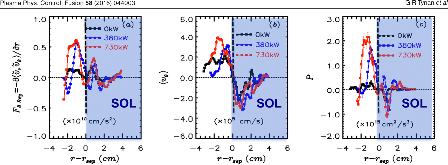Recent progress towards a physics-based understanding of the H-mode transition
- Univ. of California, San Diego, CA (United States). Center for Momentum Transport & Flow Organization (CMTFO)
- Univ. of California, San Diego, CA (United States). Center for Momentum Transport & Flow Organization (CMTFO) and Center for Astrophysics & Space Science
- Univ. of California, San Diego, CA (United States). Center for Astrophysics & Space Science
- Massachusetts Inst. of Technology (MIT), Cambridge, MA (United States). Plasma Science and Fusion Center (PSFC)
Results from recent experiment and numerical simulation point towards a picture of the L-H transition in which edge shear flows interacting with edge turbulence create the conditions needed to produce a non-zero turbulent Reynolds stress at and just inside the LCFS during L-mode discharges. This stress acts to reinforce the shear flow at this location and the flow drive gets stronger as heating is increased. The L-H transition ensues when the rate of work done by this stress is strong enough to drive the shear flow to large values, which then grows at the expense of the turbulence intensity. The drop in turbulence intensity momentarily reduces the heat flux across the magnetic flux surface, which then allows the edge plasma pressure gradient to build. A sufficiently strong ion pressure gradient then locks in the H-mode state. The results are in general agreement with previously published reduced 0D and 1D predator prey models. An extended predator–prey model including separate ion and electron heat channels yields a non-monotonic power threshold dependence on plasma density provided that the fraction of heat deposited on the ions increases with plasma density. Possible mechanisms to explain other macroscopic transition threshold criteria are identified. A number of open questions and unexplained observations are identified, and must be addressed and resolved in order to build a physics-based model that can yield predictions of the macroscopic conditions needed for accessing H-mode.
- Research Organization:
- Massachusetts Inst. of Technology (MIT), Cambridge, MA (United States); Univ. of California, San Diego, CA (United States)
- Sponsoring Organization:
- USDOE
- Grant/Contract Number:
- FC02-99ER54512; SC0008689; SC0008378; SC0001961
- OSTI ID:
- 1235490
- Alternate ID(s):
- OSTI ID: 1235967; OSTI ID: 1438464
- Journal Information:
- Plasma Physics and Controlled Fusion, Journal Name: Plasma Physics and Controlled Fusion Vol. 58 Journal Issue: 4; ISSN 0741-3335
- Publisher:
- IOP ScienceCopyright Statement
- Country of Publication:
- United Kingdom
- Language:
- English
Web of Science
Similar Records
The Center for Momentum Transport and Flow Organization in Plasmas - Final Scientific Report
The role of zonal flows and predator–prey oscillations in triggering the formation of edge and core transport barriers








